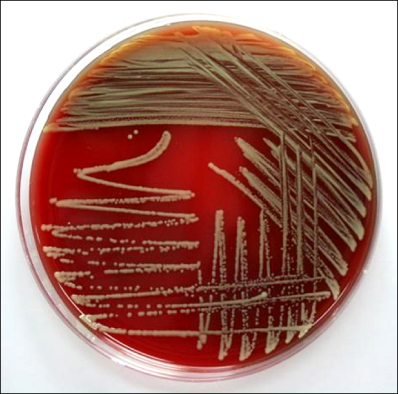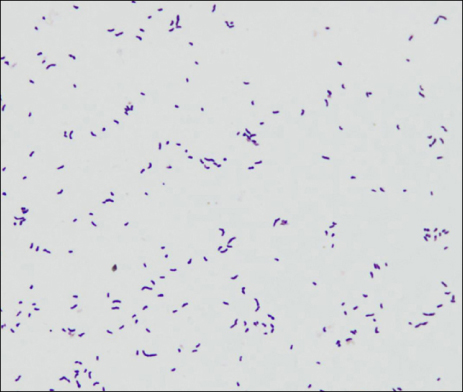Korean J Clin Microbiol.
2012 Sep;15(3):110-113. 10.5145/KJCM.2012.15.3.110.
A Case of Bacteremia Due to Microbacterium oleivorans Identified by 16S rRNA Sequencing Analysis
- Affiliations
-
- 1Department of Laboratory Medicine, Chung-Ang University College of Medicine, Seoul, Korea. cpworld@cau.ac.kr
- KMID: 1434169
- DOI: http://doi.org/10.5145/KJCM.2012.15.3.110
Abstract
- Microbacterium oleivorans is a gram-positive, coryneform rod bacterium. The pathogenic potential of the Microbacterium species has recently been reported to be increasing. Microbacterium comprises approximately 50 species. The differences in regards to the biochemical characteristics of Microbacterium species are unclear, and is why molecular investigations (e.g., using 16S rRNA gene sequencing) are the best method to identify the species. We report a case of bacteremia that was caused by Microbacterium oleivorans in a 4-year-old boy, who had no specific medical history. This represents the first report of M. oleivorans bacteremia in Korea.
Keyword
MeSH Terms
Figure
Reference
-
1. Versalovic J, Carroll KC, editors. Manual of Clinical Microbiology. 2010. 10th ed. Washington, DC: American Society for Microbiology;413–442.2. Alonso-Echanove J, Shah SS, Valenti AJ, Dirrigl SN, Carson LA, Arduino MJ, et al. Nosocomial outbreak of Microbacterium species bacteremia among cancer patients. J Infect Dis. 2001. 184:754–760.3. Lau SK, Woo PC, Woo GK, Yuen KY. Catheter-related Microbacterium bacteremia identified by 16S rRNA gene sequencing. J Clin Microbiol. 2002. 40:2681–2685.4. Laffineur K, Avesani V, Cornu G, Charlier J, Janssens M, Wauters G, et al. Bacteremia due to a novel Microbacterium species in a patient with leukemia and description of Microbacterium paraoxydans sp. nov. J Clin Microbiol. 2003. 41:2242–2246.5. Kim CH, Suk JE, Han WS, Kim YH, Hwang BY, Jeong HW, et al. A case of native valve infective endocarditis caused by Microbacterium species. Korean J Med. 2004. 67:Suppl 3. S923–S926.6. Gneiding K, Frodl R, Funke G. Identities of Microbacterium spp. encountered in human clinical specimens. J Clin Microbiol. 2008. 46:3646–3652.7. Moon CJ, Shin JH, Jeong ES, Kee SJ, Kim SH, Shin MG, et al. Central venous catheter-related Microbacterium bacteremia identified by 16S ribosomal RNA gene sequencing. Korean J Clin Microbiol. 2009. 12:97–101.8. Woo HI, Lee JH, Lee ST, Ki CS, Lee NY. Catheter-related bacteremia due to Microbacterium oxydans identified by 16S rRNA sequencing analysis and biochemical characteristics. Korean J Clin Microbiol. 2010. 13:173–177.9. Enoch DA, Richardson MP, Hill RL, Scorer PM, Sismey A. Central venous catheter-related bacteraemia due to Microbacterium paraoxydans in a patient with no significant immunodeficiency. J Clin Pathol. 2011. 64:179–180.10. Adderson EE, Boudreaux JW, Hayden RT. Infections caused by coryneform bacteria in pediatric oncology patients. Pediatr Infect Dis J. 2008. 27:136–141.11. Ko KS, Oh WS, Lee MY, Peck KR, Lee NY, Song JH. A new Microbacterium species isolated from the blood of a patient with fever: Microbacterium pyrexiae sp. nov. Diagn Microbiol Infect Dis. 2007. 57:393–397.12. Adderson EE, Boudreaux JW, Cummings JR, Pounds S, Wilson DA, Procop GW, et al. Identification of clinical coryneform bacterial isolates: comparison of biochemical methods and sequence analysis of 16S rRNA and rpoB genes. J Clin Microbiol. 2008. 46:921–927.13. CLSI. CLSI Document MM18-A. Interpretive Criteria for Identification of Bacteria and Fungi by DNA Target Sequencing; Approved Guideline. 2008. Wayne, PA: Clinical and Laboratory Standard Institute.14. Behrman RE, Kliegman RM, editors. Nelson Textbook of Pediatrics. 2004. 17th ed. Philadelphia: Saunders;842–843.15. Schippers A, Bosecker K, Spröer C, Schumann P. Microbacterium oleivorans sp. nov. and Microbacterium hydrocarbonoxydans sp. nov., novel crude-oil-degrading Gram-positive bacteria. Int J Syst Evol Microbiol. 2005. 55:655–660.16. Funke G, Lawson PA, Nolte FS, Weiss N, Collins MD. Aureobacterium resistens sp. nov., exhibiting vancomycin resistance and teicoplanin susceptibility. FEMS Microbiol Lett. 1998. 158:89–93.
- Full Text Links
- Actions
-
Cited
- CITED
-
- Close
- Share
- Similar articles
-
- Catheter-related Bacteremia due to Microbacterium oxydans Identified by 16S rRNA Sequencing Analysis and Biochemical Characteristics
- Central Venous Catheter-Related Microbacterium Bacteremia Identified by 16S ribosomal RNA Gene Sequencing
- A Case of Bacteremia Caused by Leuconostoc lactis Identified by 16S rRNA Sequencing
- A Case of Bacteremia Caused by Arcobacter butzleri
- A Case of Klebsiella pneumoniae Unidentified by Conventional Biochemical Tests



